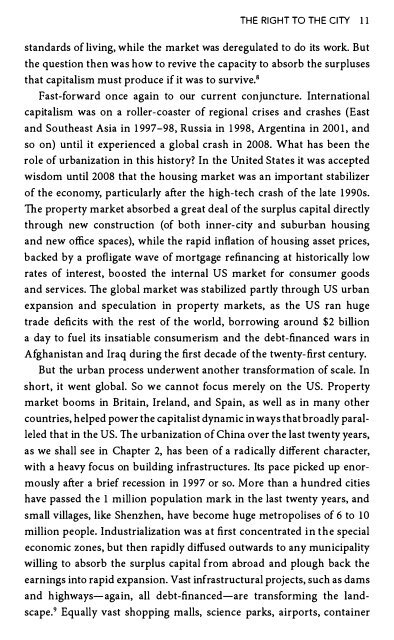Rebel Cities-David Harvey
Rebel Cities-David Harvey
Rebel Cities-David Harvey
- No tags were found...
You also want an ePaper? Increase the reach of your titles
YUMPU automatically turns print PDFs into web optimized ePapers that Google loves.
THE RIGHT TO THE CITY 11standards of living, while the market was deregulated to do its work. Butthe question then was how to revive the capacity to absorb the surplusesthat capitalism must produce if it was to survive.8Fast-forward once again to our current conjuncture. Internationalcapitalism was on a roller-coaster of regional crises and crashes (Eastand Southeast Asia in 1997-98, Russia in 1998, Argentina in 200 1, andso on) until it experienced a global crash in 2008. What has been therole of urbanization in this history? In the United States it was acceptedwisdom until 2008 that the housing market was an important stabilizerof the economy, particularly after the high-tech crash of the late 1990s.The property market absorbed a great deal of the surplus capital directlythrough new construction (of both inner- city and suburban housingand new office spaces), while the rapid inflation of housing asset prices,backed by a profligate wave of mortgage refinancing at historically lowrates of interest, boosted the internal US market for consumer goodsand services. The global market was stabilized partly through US urbanexpansion and speculation in property markets, as the US ran hugetrade deficits with the rest of the world, borrowing around $2 billiona day to fuel its insatiable consumerism and the debt-financed wars inAfghanistan and Iraq during the first decade of the twenty-first century.But the urban process underwent another transformation of scale. Inshort, it went global. So we cannot focus merely on the US. Propertymarket booms in Britain, Ireland, and Spain, as well as in many othercountries, helped power the capitalist dynamic in ways that broadly paralleledthat in the US. The urbanization of China over the last twenty years,as we shall see in Chapter 2, has been of a radically different character,with a heavy focus on building infrastructures. Its pace picked up enormouslyafter a brief recession in 1997 or so. More than a hundred citieshave passed the 1 million population mark in the last twenty years, andsmall villages, like Shenzhen, have become huge metropolises of 6 to 10million people. Industrialization was at first concentrated in the specialeconomic zones, but then rapidly diffused outwards to any municipalitywilling to absorb the surplus capital from abroad and plough back theearnings into rapid expansion. Vast infrastructural projects, such as damsand highways-again, all debt-financed-are transforming the landscape.9Equally vast shopping malls, science parks, airports, container


